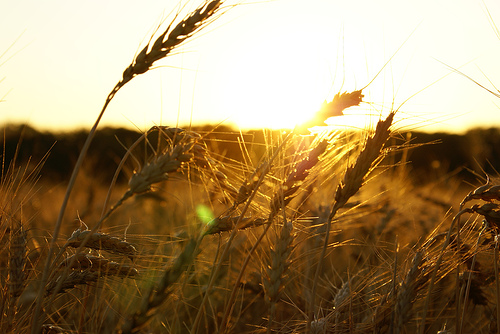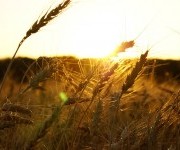 Kansas wheat.Photo: Brian McGuirkMy father farmed in Kansas and envied those lucky farmers in the wetter states to the east of us, who could grow 200-bushel corn and other lucrative crops like soy beans and sugar beets. He had to satisfy himself with wheat, a drought-tolerant crop first brought to the States from a place in Russia much like ours. There, they called such arid places “steppes.” Here, we called them “plains.”
Kansas wheat.Photo: Brian McGuirkMy father farmed in Kansas and envied those lucky farmers in the wetter states to the east of us, who could grow 200-bushel corn and other lucrative crops like soy beans and sugar beets. He had to satisfy himself with wheat, a drought-tolerant crop first brought to the States from a place in Russia much like ours. There, they called such arid places “steppes.” Here, we called them “plains.”
To look at the pale-green buffalo grass that covered the High Plains, you would never suspect that an aquifer holding as much water as Lake Huron lay beneath. But we knew about the aquifer. Its waters seeped to the surface in some otherwise dry creek beds, feeding rare ponds where we sometimes went fishing. And my pioneer grandparents had drilled down into the aquifer and erected windmills that we relied on to pump the water we needed to exist.
The technology to tap more water from the aquifer arrived in the 1940s, but it wasn’t until the mid-sixties that my family had saved enough to drill our first irrigation well. Bumper profits rolled in. By the time we sold our farm in 2006, we had five wells pumping 200 million gallons out of the aquifer every growing season. In all, Plains farmers were pumping 6 trillion gallons. That’s 1.5 trillion more than the Colorado River carries to the Southwestern United States.
 The Ogallala Aquifer sits below 174,000 square miles of crop and rangeland from South Dakota to Texas.The Ogallala Aquifer is vast. It underlies portions of eight large states — 174,000 square miles of crop and rangeland all the way from South Dakota to Texas. But it is also invisible. So it’s not surprising that until the debate over the Keystone XL pipeline erupted, few people had ever heard of it. Then for several months, its melodious name was broadcast all over the national news. Now that the aquifer is safe from the pipeline (for the time being), there’s another risk worth examining: industrial agriculture.
The Ogallala Aquifer sits below 174,000 square miles of crop and rangeland from South Dakota to Texas.The Ogallala Aquifer is vast. It underlies portions of eight large states — 174,000 square miles of crop and rangeland all the way from South Dakota to Texas. But it is also invisible. So it’s not surprising that until the debate over the Keystone XL pipeline erupted, few people had ever heard of it. Then for several months, its melodious name was broadcast all over the national news. Now that the aquifer is safe from the pipeline (for the time being), there’s another risk worth examining: industrial agriculture.
Nebraska landowners stepped up to protect the Ogallala from potential pipeline spills. Now they should do their damndest to stop the overpumping and nonpoint-source pollution that have already made parts of it unusable. If it is not protected, then many parts of the aquifer will either run dry or be too polluted to use by the end of this century. This is especially frightening because it would take thousands of years for the Ogallala to replenish itself.
While in most cases groundwater is “owned” by states, which oversee the rights of farmers to tap it, the federal government greatly influences how much farmers use. Corn is one of the most water-intensive crops grown in the region, demanding over a foot of irrigation water in the western Kansas climate, and closer to 20 inches in hotter parts of Texas. Yet the federal government mandates ethanol production. Responding to the resulting increase in corn prices, farmers have expanded their corn acreage by 16 percent.
Corn is also a “heavy feeder,” meaning it demands more fertilizers than most other crops. Genetically modified “Roundup Ready” corn predominates. As weeds have developed resistance to the herbicide glyphosate, or Roundup, use of other chemicals has intensified. Those nitrogen fertilizers and pesticides leach downward in the soil, eventually poisoning wells. They also run off into rivers, corrupting city water supplies and ultimately adding to the dead zone in the Gulf of Mexico. Tax credits and tariff protection for ethanol will expire in early 2012, and there is increasing support for ending, or at least trimming, the mandate.
But the federal government also encourages corn planting through subsidies to farmers. Growers receive direct payments, help with crop insurance, and price guarantees on their crops. A new, less obvious approach has been proposed for the 2012 Farm Bill that would guarantee farmers’ income by expanding federally underwritten crop insurance. While direct payments have come under fire from both the left and the right, this new approach ultimately changes very little.
The Environmental Working Group and many other sustainable farming organizations are insisting that aid for farmers should be tied to conservation measures. I support this, but it’s not enough. The 2012 Farm Bill must also take North America’s largest aquifer into consideration. The bill can help end the current unsustainable mining of the Ogallala by excluding those who raise water-intensive crops like irrigated corn, cotton, and sugar beets from receiving direct payments or help with crop insurance, whether in its old or enhanced form.
I do not suggest this because I think the Ogallala will ever be what it once was; I know the ponds of my childhood won’t magically come back. As much as I’d like today’s Plains children to know the joys of pulling perch from my father’s old fishing holes, those days are over. No, it is simply so that future generations might turn on a faucet and get a drink.



